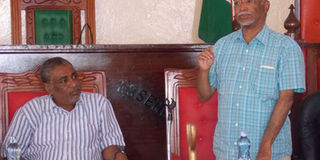Government needs to work harder to support independent power producers

Habin Jelani (right), director of Amu Power, one of the sponsors of the project to establish a coal-fired power plant in Lamu, addresses ward representatives at the County Assembly on August 8, 2016. Looking on is the House's Deputy Speaker Azhar Mbarak. PHOTO | KALUME KAZUNGU | NATION MEDIA GROUP
What you need to know:
The big question is whether the people in the institutions charged with the responsibility of adjudicating complaints raised by the public have the capacity and skills to deliver within the time frames and deadlines set by the lenders of the projects.
Do these guys factor in investment climate concerns and do they care about what their actions are likely to do to the energy sector’s risk profile?
If you asked me to name just one recent event that has caused the biggest scare to investors interested in developing projects in the energy sector — and which has the potential of doing great damage to the flow of private sector investment in energy — I would quickly name the Kinangop wind power project.
Indeed, developers and international financial institutions are keenly following the news of the collapse of the project and the way the matter is being handled because it reflects on the ability of the government to exert its authority to protect and deliver on the obligations that it signs when investors and developers commit themselves to and take risks on large infrastructure projects in this country.
As things stand, the taxpayer risks paying billions of shillings to the developers of the Kinangop project.
I make these remarks as an entry point to the controversy surrounding the proposed Lamu coal plant.
The other day, the Energy Regulatory Commission (ERC), acting on representation by a group called Save Lamu, announced that it was putting on hold the granting of a generation licence to the developers of the proposed Lamu coal plant until public hearings on environmental concerns have been addressed.
I have read both the representations of Save Lamu and the ERC letter communicating its decision to put the licensing of the project on hold. Without a doubt, Save Lamu has made very valid points in terms of highlighting both environmental and economic arguments.
LOBBY GROUP
Indeed, the trend in our country is that you cannot complete a major infrastructure project today without encountering some lobby group bent on mobilising rural communities to block it for one excuse or another.
The big question is whether the people in the institutions charged with the responsibility of adjudicating complaints raised by the public have the capacity and skills to deliver within the time frames and deadlines set by the lenders of the projects.
Do these guys factor in investment climate concerns and do they care about what their actions are likely to do to the energy sector’s risk profile? And when disasters such as what happened at the Kinangop wind power project happen, how much reflection is done to avoid future problems?
In the Lamu coal project case, the following facts are irrefutable: First, the National Environment Management Authority (Nema) completed the environment impact assessment process several months ago. Secondly, public hearings were conducted on August 28, 2006.
Which begs the question: Do Nema reports matter to developers at all and if so, is it fair or transparent for the ERC to arbitrarily disregard and throw away what has been approved by the primary regulator on environmental issues and to subject the investor to a totally new process?
Where is predictability for investors when the playing ground is allowed to shift according to the whims of bureaucrats?
Make no mistake, I am not saying that the Lamu coal plant is perfect. I am concerned about the investment climate and the risk profile the energy sector is beginning to assume.
TOO LONG
We must remember that large infrastructure projects burn a lot of cash upfront. When things drag for too long, you find yourself facing financiers because loans will have matured.
And, as amply demonstrated by the Kinangop wind power case, financiers will not spare you just because you are still haggling with noisy environmental lobby groups or the government is not able to provide the promised land.
Who was supposed to provide land for the Kinangop project? Does it matter to an investor that his project has “a letter of support” from the government? The legal disputes around Kinangop will provide answers.
In retrospect, we have progressed a great deal from the days when independent power producers such as Kinangop or Lamu coal would only construct projects on the strength of letters of credit by Kenya Power more or less paying them in advance. We were that desperate.
Then there was a time when the government would issue sovereign guarantees to developers. Today, the government issues them with “letters of support”. Where financiers have insisted that the letter of credit is not enough, they seek partial risk guarantees from multilateral financial institutions, including the World Bank and the African Development Bank.
The government needs to work harder to deliver on the letters of support it issues to independent power producers.
At the rate things are going, we will soon start seeing investors and developers in the energy sector seeking insurance against arbitrary regulation and unpredictable changes to the law.





